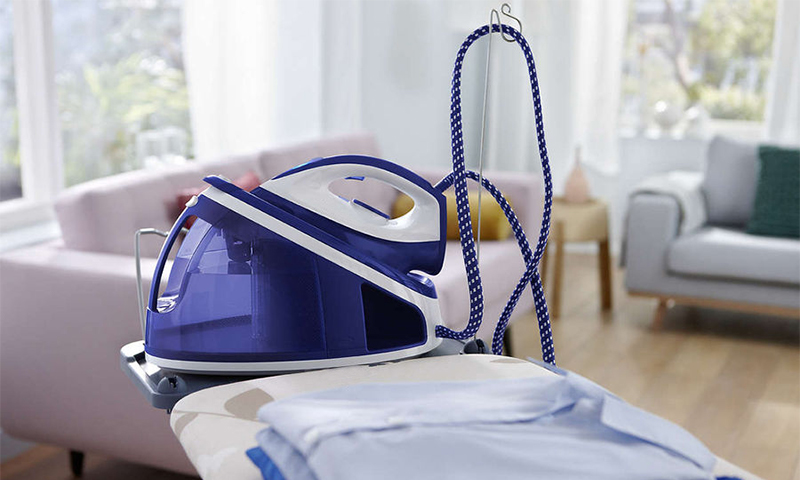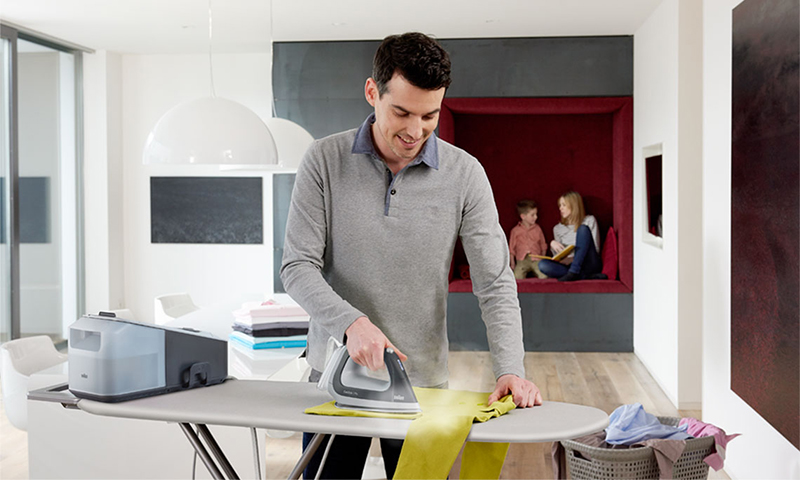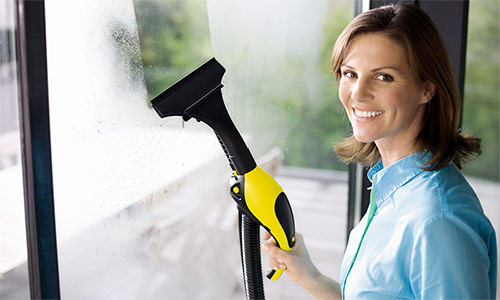Some things just can not be ironed - even at the lowest temperature. In order not to damage the delicate fabric, beautiful embroidery or a scattering of beads and sequins, clothing should be steamed. And it is more convenient to do this with a special device. But since many of us have steamers otparivateli, it will be difficult to choose the right model. Yes, and to use such units need skillfully. Our article will help you with the first question, you will have to deal with the second one yourself. But you should not be afraid - you will get comfortable quickly, and it’s almost impossible to spoil your favorite thing.

Content:
The best manufacturers of steamers for clothes - which company to choose
For those who are not ready to delve into the features of modern ironing equipment, it will be enough to remember a list of the best brands of steamers that will never let you down:
- Philips
- MIE
- Karcher
- Kitfort
- Polaris
You will find excellent models of steamers from these manufacturers with a description of all their pros and cons in the article about best steamers. However, before that, we still advise you to read about the rules for choosing such equipment, taking into account the peculiarities of your wardrobe, so that you do not have to go back into the closet for the old iron.
Principle of operation and device
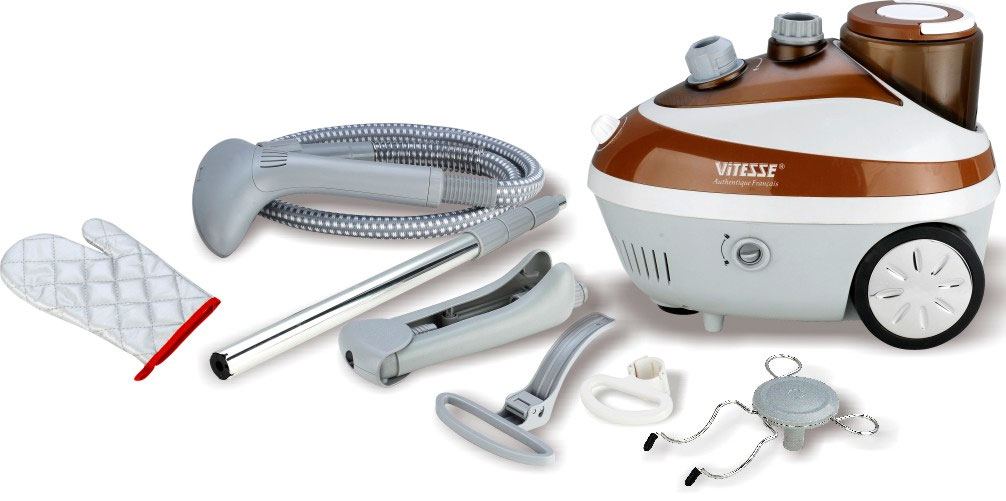
There is nothing complicated in the design of household steamers for clothes - everything here works like an electric kettle. Water is poured into the tank, where it is heated by ordinary heating elements, catching up to +100 ° C. The formed wet steam comes out through a spout or a nozzle with openings.
You just have to drive this "iron" on the hanging fabric, gently leveling the fibers. Such processing is absolutely harmless even for very thin and delicate materials. At the same time, hot steam perfectly smoothes them, leaving no random wrinkles and “prints” of internal seams, like after an iron.
The internal structure of steamers working under pressure is a little more complicated. Here, the capacity of the evaporator is closed with a tight valve. It does not let out steam until there is enough pressure inside or you press the button, releasing it. These models are more effective and able to cope with heavy autumn jackets, winter coats and even fur products.
Different types of steamers can have their own design features (tripod, extended handle, supply hose), but by and large they consist of only three main elements:
- Water tank;
- Boiler compartment;
- Spout or iron with holes for steam.
Types of steamers for clothes
Hand held
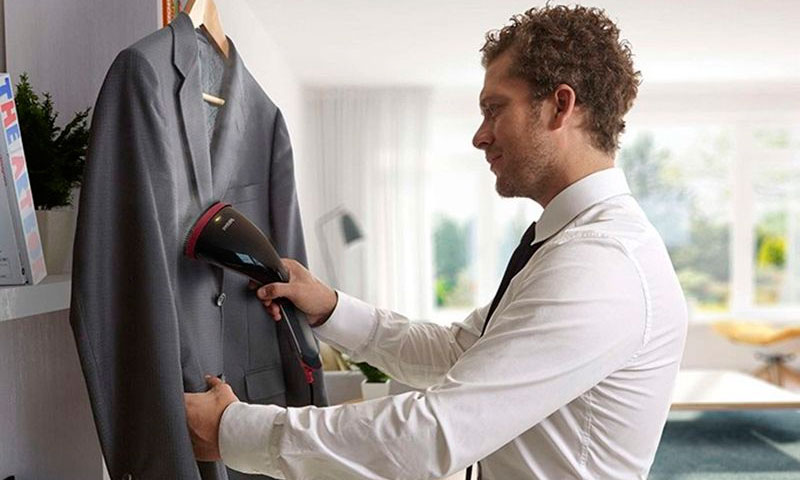
Most compact models often have the appearance of a clothes brush (only lint-free) or a small kettle with a spout-ironing. The small case does not allow to hide inside powerful TEN or capacious capacity for water. But such steamers calmly fit into a travel bag.
Pros:
- The convenience of use;
- Small weight and compact size;
- It is easy to reach the top of the curtains on the eaves;
- There are models that work autonomously - from batteries;
- Low cost.
Minuses:
- Small tank volume;
- Low feed rate;
- Not adapted for long-term work - a limit of 15-30 minutes followed by a break.
Hand otparivateli more convenient to take with you on the road or on a business trip, when you need to put in order one or two things of personal wardrobe, and not a whole pile of linen.
Vertical

All budget models of floor steamers have self-flowing steam supply system. Being formed in the boiler of the lower box, it is pressed through the hose to the ironing nozzle. Because of this short journey, the outlet temperature drops slightly - up to +98 .. + 99 ° C, but the steam still works. Such devices are suitable for care of fabrics of average density.
Also in this family there are steamers working under pressure. They give a stream of steam about 3 atm, which allows it to penetrate deeply even through dense coarse fabrics.
Pros:
- The large volume of the tank increases the duration of work on one filling up to 1–2 hours;
- Easy handling - you need to keep only a light iron in your hands;
- Simplicity and reliability of the design;
- Affordable price.
Minuses:
- Rather big sizes;
- High power consumption;
- It is necessary to wait until the water heats up (and the necessary pressure is reached).
Vertical models are very comfortable when ironing everyday clothes. They always come with a tripod on which to hang the hangers and hang things for steaming.
Pump action
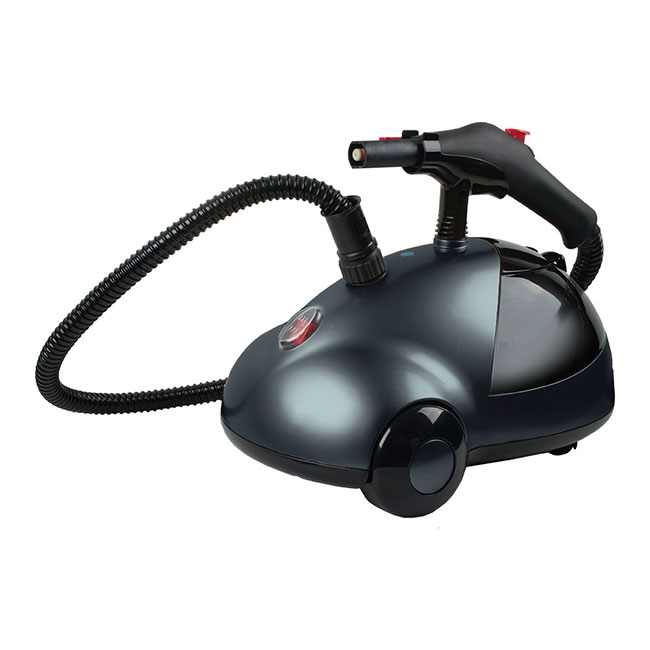
These devices also work with forced supply of steam under pressure, it is only formed a little differently. The entire volume of water poured into the reservoir does not boil here - it is pumped to the hot heating element drop by drop and evaporates sharply. It turns out a kind of mini-explosion, which increases the pressure in the boiler chamber. Then everything works as standard: the valve opens, and the steam with a force breaks out. You control this process yourself - with the help of a button located on the iron.
Pros:
- More intense steam flow;
- Fast and effective smoothing things;
- Pressurized steam easily penetrates even thick fabric;
- Convenient feed management;
- Unlimited time of continuous work (if only there is enough water).
Minuses:
- The pressure of the released steam drops rapidly;
- Quite a price.
Pump steamers work best with ironing heavy things from fur and thick fabrics (drape, tweed and felt).
Combined
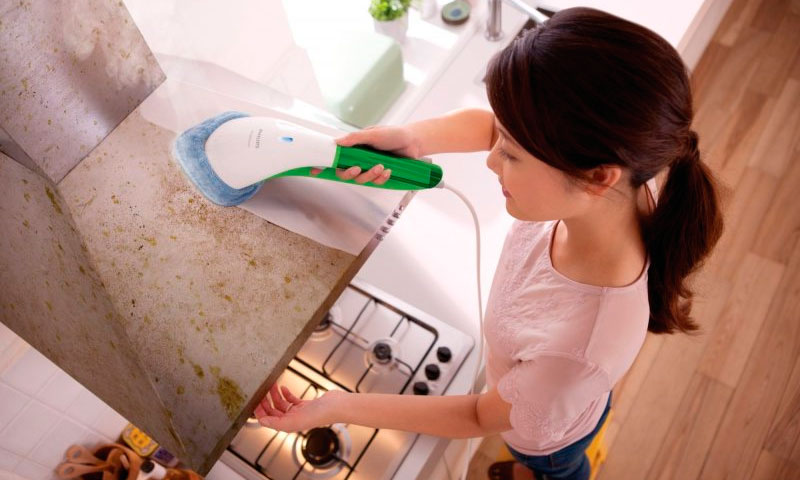
Represent a hybrid of a otparivatel for clothes and a household steam cleaner that does them more effectively and more functionally. Here, steam is supplied under constant pressure (from 3 atm and higher) and can be used not only for ironing, but also for safe cleaning in the house or cleaning of heat-resistant surfaces.
Pros:
- Ability to handle heavy fabrics;
- Disinfection and elimination of unpleasant odors;
- A large number of interchangeable nozzles in the kit;
- Functionality.
Minuses:
- High price.
- Give out an excess amount of steam.
Perfectionists and fans of absolute purity without the use of chemistry will appreciate the possibilities of combined steam cleaners. Changing nozzles, with the same device, it is possible to tidy up capricious things and clean the tiles in the kitchen from grease.
Selection options
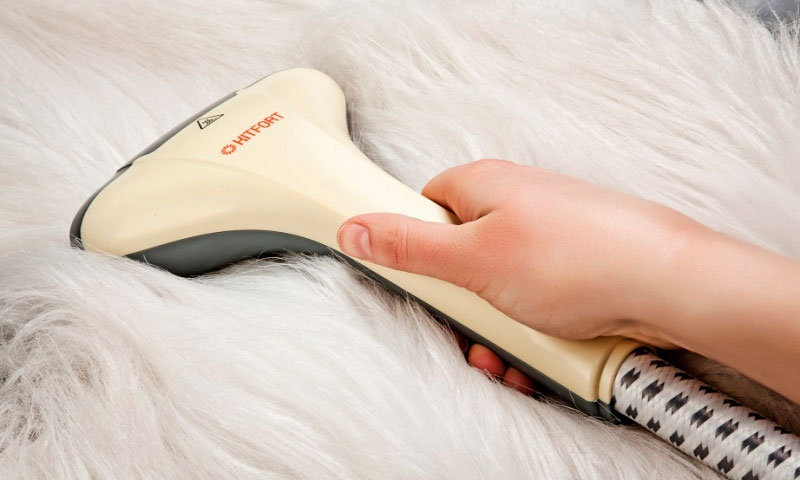
Steam supply intensity
This characteristic is directly related to the power of the equipment and determines how thick the fabric can smooth such a steamer, and how quickly it will cope with them.
The average feed rate of 30–50 g / min is enough to clean up your home textiles and most of your wardrobe items. Vertical steamers of an average price category with a capacity from 1.5 to 2.3 kW have such parameters. With one adult thing they cope in 1.5-2 minutes.
In most budget and manual models, the flow rate is much lower (13-20 g / min) with power up to 1.5 kW. They take about 3 minutes to steam off, say, a men's shirt.
Intensities of 55–70 g / min show pump units supplying steam under pressure. Here power is not critical, and ironing one thing takes a minute and a half.
You should not jump above the given figures if your task is to iron the clothes and not wet them. However, the combined steam cleaners can get a stream of 85 g / min or more, but after this treatment, things will have to be left to dry.
Tank volume
This figure determines how long you can work with the steamer on one refueling. The volume of the water tank depends on the design of the device:
- from 50 to 800 ml contain manual models;
- from 750 ml to 3.8 l - outdoor.
If you are going to smooth a whole pile of clothes with a steam device, it is better if its capacity is at least 1–2 liters. This is usually enough for half an hour of work. It is important that the unit itself is designed for such long use.
Heel material ironing
Many believe that it does not matter, because the temperature at the outlet of the steamer is relatively low, and contact with the cloth is minimal. In fact, the speed of its warming up, that is, the time it takes to wait before ironing, depends on the material of the nozzle. Otherwise the steam will simply condense on the iron and leave wet stains on the clothes.
Manufacturers offer 3 options to choose from:
- Plastic - light, cheap, “warm”, but short-lived;
- Metal is good if the iron has a heating function, otherwise steam will condense on it;
- Ceramics - like metal, will take 5 minutes to warm up.
All of the above materials do a good job with their work, but if you don’t want to waste time and electricity to heat up the iron, you should stop at the plastic nozzles. At least - when buying small steamers with a short cycle of continuous operation.
Equipment
Much depends on the cost of the steamer, but in fairness, we note that most of the complete nozzles are virtually useless. Of the necessary can only be called a brush for cleaning clothes and clips, which are used to renew trouser arrows. All other accessories are desirable, but even without them easy to do.
These optional items include:
- Plate for steaming pockets;
- Heatproof mitten;
- Dot nozzle;
- Hangers - if we take, then sliding, with adjustable size.
For outdoor models, you should also pay attention to the design of the rack. Here are the following options:
- Disposable - suitable if you use a steamer every day or have enough free space to store it in full size.
- Telescopic - folds and folds, if necessary, remove the steamer before the next ironing.
You should also pay attention to the height of the standard rack and the ability to adjust it. Well, if she is 15–20 cm taller than the owner or hostess, then it will be more convenient to use it. Alas, in most cases, you have to be content with what manufacturers offer - steamers with racks from 165 to 185 cm.
What clothes steamer to choose
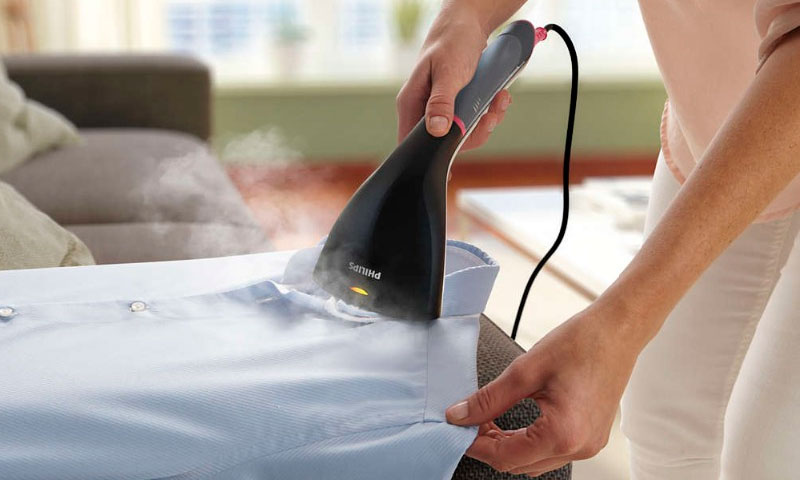
1. If you only need to refresh a set of clothes (on the road, on a business trip, or just before going to work), take a small hand-steamer with a reservoir of up to 200 ml. It will also be useful to care for the curtains, if you do not remove them from the eaves - the length of the floor model hose simply will not allow you to reach the very top of the panels.
2. To take care of all your wardrobe (including jeans and heavy coats made of thick fabric with lining) you will need a powerful steamer. Not less than 1700 W with a steam supply rate of 30–50 g / min and preferably under pressure.
3. In the studio and shops where you need to smooth out a lot of different things, and good speed is important, only a powerful steamer can cope with the task, creating a pressure of 2-3 atm at the outlet. This should be a floor pump model with a tank capacity of at least 3 liters. And the adjustable steam supply will allow not to spend it in vain.
4. If you like multifunctional equipment or simply do not have the ability to store a whole fleet of household appliances in the house, buy one combined model instead of a steam generator and a steamer. She and things will help to maintain in order, and bring perfect cleanliness in all rooms. The volume and power here in any case will be sufficient, the main thing is that the function of horizontal steam is present.
How much are steamers for clothes
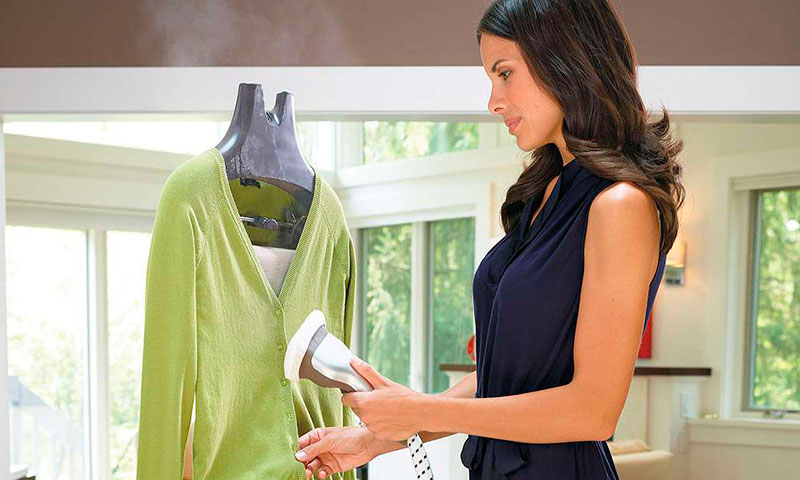
1. “Road” steamer, depending on the manufacturer, will cost in the range of 500-7000 rubles.
2. Manual model, but in the form of a kettle and, accordingly, with a large volume of the tank will be cheaper - from 400 to 2500 rubles.
3. The gravity floor otparivatel can be bought for 2–4 thousand, with steam supply under pressure - from 3 to 6 thousand rubles.
4. Universal steamers with an additional cleaning function cost about 5,000–7,000 rubles.
It will be interesting to friends too

